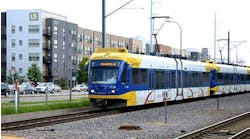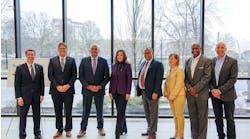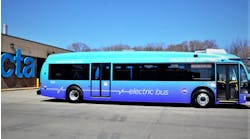Paul Ballard
Chief Executive Officer
Nashville MTA & Regional Transportation Authority
One of the biggest stars in Nashville these days is the Music City Star, a commuter train running 30 miles east from Nashville along the I-40 corridor to Lebanon, Tennessee. Built for just over $40 million, the lowest cost of any similar project in the country, the Star pioneers the role of rail transit for residents of Middle Tennessee.
We’re fortunate to have this existing rail line; and our elected officials, business and community leaders are actively engaged in a regional effort to move forward with multimodal transportation throughout the nine counties that comprise our Regional Transportation Authority. Together, we’ve taken three major steps toward progress over the last several months:
First, Mayor Karl Dean of Nashville initiated the Middle Tennessee Mayors Caucus, which includes city and county officials and is led by Mayor Jo Ann Graves of Gallatin, an outlying community, who will collaborate on the region’s long range plans.
Second, inspired in part by the Mayors Caucus, the Tennessee Legislature passed laws enabling regional transportation authorities, such as our RTA, to establish dedicated funding sources for public transportation. Dedicated funding will maximize allocation of federal funds, and the state enabling legislation leaves leeway for regional communities to choose the method of local match best suited to them.
Third, our business and civic leaders have organized the Transit Alliance of Middle Tennessee. A leading corporate citizen, Vanderbilt University, which is also Nashville’s largest private employer, volunteered the initial financial commitment. The Alliance will raise the profile of public transit among the public and business communities.
In addition, the Nashville MTA and the Metropolitan Planning Organization continually update master plans based on extensive hearings and community input.
The support of these community leaders and officials spell success for identifying and establishing support for rail projects in any community.
Recently, however, I’m astounded and gratified by the grassroots movements of activists and consumers who have materialized, unbidden, beside MTA and RTA in Nashville. With petitions, blogs, websites, videos, and information booths at events such as Earth Day, they voice their support of improved and innovative public transportation, including streetcars and light rail. Unlike the bus and rail enthusiasts who have supported our projects for decades, these volunteers are environmentalists and civic activists concerned with eliminating congestion and promoting smart growth. We have only to embrace their support in the most effective ways possible.
Can Nashville become the “Greenest City in the South,” as our Mayor has challenged?
If community support is the answer, we’re on track.
Keith Jones
Vice President and Regional Transit Manager
URS Corp.
If your assignment is to develop and open a new rail project in your service area, your job just got a lot harder. Obtaining and maintaining public support has become even more of a challenge because of growing resistance to government-led initiatives. Is this a fundamental change in our nation’s politics and public policy debate? Is it right or wrong? I’ll leave those questions for others to analyze. But in the here and now of 2010, a new rail or other fixed-guideway project could be just the thing that unites a community, or it could become the centerpiece for one of the new wave of rallies where they don’t necessarily serve tea but there is often somebody in hot water.
So how do you get and keep that most valuable commodity, the public trust? Isn’t it enough to simply manage the usual challenges? It takes years to get the long-range plan approval, major financing, environmental clearances and all the agreements that have to be negotiated. This is true of a brand new 3-mile streetcar project, a 30-mile commuter rail line using existing track and right of way, or a new cross-town light rail line. But none of those challenges can be met without sustainable community support. A project may have had a winning margin in a referendum somewhere in its history, but projects (and project advocates) have been brought down when that electoral support erodes and becomes a “that was then, this is now” situation. Your project model may be just the reverse, wherein you invest years in advancing the project and you think you have community support, but come the day of the referendum and the project gets thumped by the electorate (which is not always the same as the community anymore), you will be looking for your pollster who just left on vacation.
Referendum or not, it’s a long ride from the project kickoff meeting to ribbon-cutting day, and not everyone makes the complete trip. If you have a record of delivering on your promises prior to becoming a rail project sponsor, chances are you will get a chance to continue showing that you and your agency can be trusted on this new endeavor even though it is going to be unlike anything you have done before. Conversely, if your bus riders or the public has a perception that a promise was broken before, you can bet you are going to hear about it over and over. So the first advice is, do your best to rehabilitate any outstanding trust issues before going forward. In these days of limited, and sometimes shrinking, revenues, bus riders are going to be wary of you taking on a big project. They will want to know what is in it for them. Keep your existing customers on your team.
The bus riders aren’t the only ones who want to know what is in it for them. The benefits of the rail project have to be clear, reasonable and they must make sense to those who may not realize any of the immediate benefits. It doesn’t matter if you have the trustworthiness of Walter Cronkite or Oprah if the project is solving a problem that doesn’t seem to exist.
Be quick to inform and slow to promise results you cannot control. Qualify those early cost estimates and opening-day pledges. Good faith efforts to establish both during the planning process are essential, but you must always, always, always point out that the project is in the planning stage and as more detail becomes known, things may change. Every cost estimate and every opening-day pledge you make will be duly recorded and will be read back to you at an inconvenient moment. Trust me. So be ready to re-state your earlier words when things change.
And they will change. You should share those changes, not “own them.” Frequent and open communication about the project’s status is critical. Communication must be consistent across all groups. Convey the same information to your board, the riders, the media and the federal agencies who might be involved. If there is an unanticipated problem, get to work solving it (that’s what you were hired to do) but don’t neglect to tell everyone that there IS a problem but you are working on the solution. Then make a pot of tea, get everyone around the table, and keep going until you get to the ribbon-cutting.



